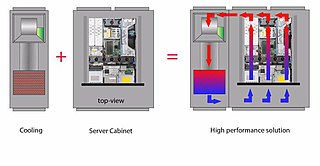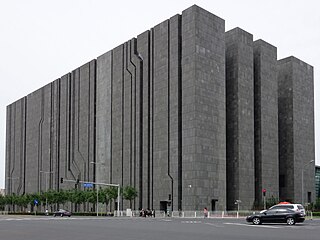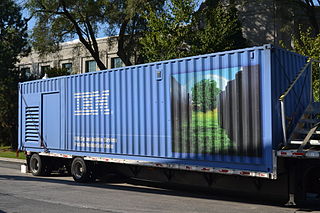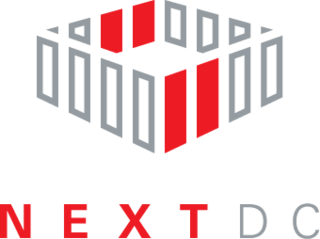 W
WA data center or data centre is a building, dedicated space within a building, or a group of buildings used to house computer systems and associated components, such as telecommunications and storage systems.
 W
WIn telecommunications, 5G is the fifth generation technology standard for broadband cellular networks, which cellular phone companies began deploying worldwide in 2019, and is the planned successor to the 4G networks which provide connectivity to most current cellphones. 5G networks are predicted to have more than 1.7 billion subscribers worldwide by 2025, according to the GSM Association. Like its predecessors, 5G networks are cellular networks, in which the service area is divided into small geographical areas called cells. All 5G wireless devices in a cell are connected to the Internet and telephone network by radio waves through a local antenna in the cell. The main advantage of the new networks is that they will have greater bandwidth, giving higher download speeds, eventually up to 10 gigabits per second (Gbit/s). Due to the increased bandwidth, it is expected the networks will not exclusively serve cellphones like existing cellular networks, but also be used as general internet service providers for laptops and desktop computers, competing with existing ISPs such as cable internet, and also will make possible new applications in internet of things (IoT) and machine to machine areas. 4G cellphones are not able to use the new networks, which require 5G enabled wireless devices.
 W
W111 Eighth Avenue is a full-block Art Deco multi-use building located between Eighth and Ninth Avenues, and 15th and 16th Streets in the Chelsea neighborhood of Manhattan, New York City.
 W
Waql is a telecommunications company based in Leeds, UK. It is principally known for operating carrier neutral data centres, and for providing services relating to colocation, mobile messaging, IP telephony, and secure mobile connectivity for the internet of things (IoT).
 W
WThe British Oceanographic Data Centre (BODC) is a national facility for looking after and distributing data about the marine environment. BODC is the designated marine science data centre for the UK and part of the National Oceanography Centre (NOC) — primarily at its facility in Liverpool, with small number of its staff in Southampton. The centre provides a resource for science, education and industry, as well as the general public.
 W
WThe R.R Donnelley Printing Plant, sometimes known as the Calumet Plant or the Lakeside Plant and now known as the Lakeside Technology Center, was built between 1912 and 1929 to house the operations of the RR Donnelley printing company. In 1993, the plant was closed after the discontinuation by Sears, Roebuck and Co. of its mail-order catalog, which had been the last major account printed there. In 1999 the building was retrofitted and is currently owned by Digital Realty Trust operating as a carrier hotel and data center. The newly outfitted building was the first and largest planned carrier hotel in the United States.
 W
WClose Coupled Cooling is a last generation cooling system particularly used in data centers. The goal of close coupled cooling is to bring heat transfer closest to its source: the equipment rack. By moving the air conditioner closer to the equipment rack a more precise delivery of inlet air and a more immediate capture of exhaust air is ensured.
 W
WColumbia Data Center is Microsoft's data center in Quincy, Washington. Property at Quincy was purchased in 2006; the building opened in April, 2007; and the data center reached operational status in May, 2007. It was said to be the largest data center in the world as of 2015. The company located there due to low land costs, abundant data fiber, and extremely low cost electricity provided by Grant County PUD for as little as 1.9 or 2.5 cents per kilowatt-hour. Building began with a 500,000-square-foot (46,000 m2) facility in 2006 and several expansions followed, occupying with 800,000 square feet (74,000 m2) of floorspace in two buildings on a 270-acre (110 ha) complex by 2016. The data center consumed 30 to 50 megawatts in 2012 and employs 50 people.
 W
WThe Digital Beijing Building is located northwest of the intersection of Beichen West and Anxiang North roads, on Olympic Green, in the Chaoyang District of Beijing, China. It is a 57-metre-tall (187 ft) block-shaped building erected to serve as a data center during the 2008 Summer Olympics. Since then it has served as both a museum devoted to the use of computing in the Olympics, and exhibition space for digital technology companies.
 W
WDigital Realty Trust, Inc. is a real estate investment trust that invests in carrier-neutral data centers and provides colocation and peering services. As of December 31, 2019, the company owned interests in 225 operating data center facilities totaling 34.5 million rentable square feet in the United States, Europe, Asia, Canada, and Australia. The companies largest operating areas are: Northern Virginia, Dallas, Chicago, New York State, Silicon Valley, and London.
 W
WEquinix, Inc. is an American multinational company headquartered in Redwood City, California, that specializes in Internet connection and data centers. The company is a leader in global colocation data center market share, with 210 data centers in 25 countries on five continents.
 W
WFlexenclosure AB is a Sweden-based developer of hybrid power systems and pre-fabricated data centres.
 W
WFoulum Data Center is an Apple data center at the village of Foulum in the Viborg Municipality, in Denmark. It opened in September 2020.
 W
WA green data center, or sustainable data center, is a service facility which utilizes energy-efficient technologies. They do not contain obsolete systems, and take advantage of newer, more efficient technologies.
 W
WThe HP Performance Optimized Datacenter (POD) is a range of three modular data centers manufactured by HP.
 W
WThe history of computing hardware covers the developments from early simple devices to aid calculation to modern day computers. Before the 20th century, most calculations were done by humans. Early mechanical tools to help humans with digital calculations, like the abacus, were referred to as calculating machines or calculators. The machine operator was called the computer.
 W
WA micro data center (MDC) is a smaller or containerized (modular) data center architecture that is designed for computer workloads not requiring traditional facilities. Whereas the size may vary from rack to container, a micro data center may include fewer than four servers in a single 19-inch rack. It may come with built-in security systems, cooling systems, and fire protection. Typically there are standalone rack-level systems containing all the components of a 'traditional' data center, including in-rack cooling, power supply, power backup, security, fire and suppression. Designs exist where energy is conserved by means of temperature chaining, in combination with liquid cooling.
 W
WThe Minnesota Technology Center, formerly called the BTC/Bunker and also known as the 511 Building in reference to its address, is a colocation center located in downtown Minneapolis, Minnesota, near U.S. Bank Stadium and the West Bank campus of the University of Minnesota. The 511 Building has been referred to as "the most wired building in Minnesota" and is a major source of fiber optic data transmission and reception. It is operated by Timeshare Systems Inc. It hosts an interchange between many major carriers, and is on the Internet Backbone.
 W
WA modular data center system is a portable method of deploying data center capacity. A modular data center can be placed anywhere data capacity is needed.
 W
WNetwork Access Point (NAP) of the Americas is a massive, six-story, 750,000 square foot data center and Internet exchange point in Miami, Florida, operated by Equinix.
 W
WNEXTDC is an Australian data centre operator. As of July 2020, the company operates 11 data centres around Australia, with facilities in Melbourne, Sydney, Brisbane, Perth, and Canberra. Two of these, B2 in Brisbane and M2 in Melbourne, operate at Tier IV standard, while the rest are Tier III.
 W
WNJFX, also known as New Jersey Fiber Exchange, is a Wall Township, NJ-based data center operator. The company offers Tier 3 data center, meet-me room and colocation services from a 58-acre site adjacent to Tata Communications' subsea cable landing station.
 W
WThe Open Compute Project (OCP) is an organization that shares designs of data center products and best practices among companies, including Facebook, IBM, Intel, Nokia, Google, Microsoft, Seagate Technology, Dell, Rackspace, Cisco, Goldman Sachs, Fidelity, Lenovo and Alibaba Group.
 W
WPionen is a former civil defence center built in the White Mountains Södermalm borough of Stockholm, Sweden in 1943 to protect essential government functions. The address of the Pionen data center is Renstiernas gata 35 and 37.
 W
WThe Portable Modular Data Center (PMDC) is a portable data center solution built into a standard 20, 40, or 53-foot intermodal container manufactured and marketed by IBM. IBM states that a PMDC cost 30% less to design and build than a traditional data center with cooling equipment.
 W
WA power distribution unit (PDU) is a device fitted with multiple outputs designed to distribute electric power, especially to racks of computers and networking equipment located within a data center. Data centers face challenges in power protection and management solutions. This is why many data centers rely on PDU monitoring to improve efficiency, uptime, and growth. For data center applications, the power requirement is typically much larger than a home or office style power strips with power inputs as large as 22 kVA or even greater. Most large data centers utilize PDUs with 3-phase power input and 1-phase power output. There are two main categories of PDUs: Basic PDUs and Intelligent (networked) PDUs or iPDUs. Basic PDUs simply provide a means of distributing power from the input to a plurality of outlets. Intelligent PDUs normally have an intelligence module which allow the PDU for remote management of power metering information, power outlet on/off control, and/or alarms. Some advanced PDUs allow users to manage external sensors such as temperature, humidity, airflow, etc.
 W
WRiverSync is a Thai corporation headquartered in Bangkok, Thailand. RiverSync sells converged micro data center, modular data center, and physical infrastructure equipment that enable businesses to rapidly deploy their computing infrastructure with prefabricated environment. RiverSync target markets including large companies and small and medium-sized businesses across various markets.
 W
WSun Modular Datacenter is a portable data center built into a standard 20-foot intermodal container manufactured and marketed by Sun Microsystems. An external chiller and power were required for the operation of a Sun MD. A data center of up to 280 servers could be rapidly deployed by shipping the container in a regular way to locations that might not be suitable for a building or another structure, and connecting it to the required infrastructure. Sun stated that the system could be made operational for 1% of the cost of building a traditional data center.
 W
WThe Utah Data Center (UDC), also known as the Intelligence Community Comprehensive National Cybersecurity Initiative Data Center, is a data storage facility for the United States Intelligence Community that is designed to store data estimated to be on the order of exabytes or larger. Its purpose is to support the Comprehensive National Cybersecurity Initiative (CNCI), though its precise mission is classified. The National Security Agency (NSA) leads operations at the facility as the executive agent for the Director of National Intelligence. It is located at Camp Williams near Bluffdale, Utah, between Utah Lake and Great Salt Lake and was completed in May 2019 at a cost estimated in 2014 to be $1.5 billion.